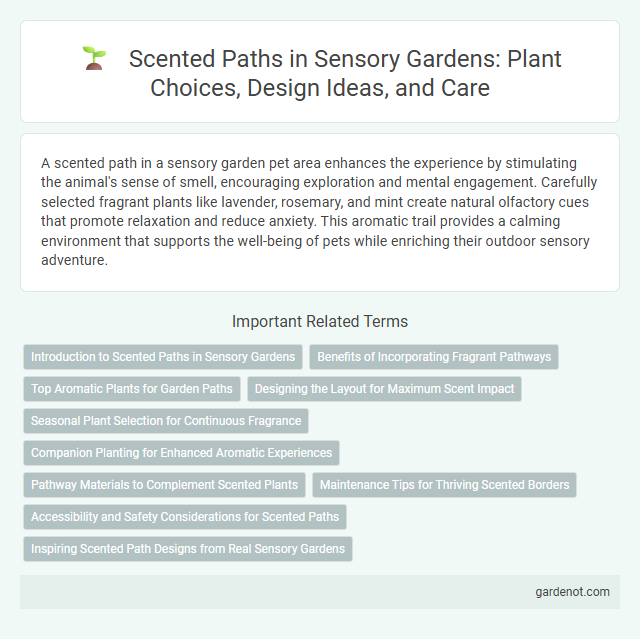A scented path in a sensory garden pet area enhances the experience by stimulating the animal's sense of smell, encouraging exploration and mental engagement. Carefully selected fragrant plants like lavender, rosemary, and mint create natural olfactory cues that promote relaxation and reduce anxiety. This aromatic trail provides a calming environment that supports the well-being of pets while enriching their outdoor sensory adventure.
Introduction to Scented Paths in Sensory Gardens
Scented paths in sensory gardens enhance olfactory experiences by incorporating aromatic plants such as lavender, rosemary, and jasmine along walkways. These pathways stimulate the sense of smell, promoting relaxation and memory recall while encouraging visitors to engage with their environment. Carefully selected fragrant flora vary seasonally to maintain continuous scent stimulation throughout the year.
Benefits of Incorporating Fragrant Pathways
Incorporating fragrant pathways in sensory gardens enhances cognitive stimulation and emotional well-being by engaging olfactory senses. Scented paths promote relaxation, reduce stress, and improve memory recall through exposure to natural aromatic compounds like lavender and rosemary. These pathways also increase accessibility and inclusivity for individuals with visual impairments by providing distinct sensory cues.
Top Aromatic Plants for Garden Paths
Top aromatic plants for garden paths include lavender, rosemary, and thyme, which emit calming and invigorating scents ideal for sensory gardens. These plants not only provide fragrant trails but also attract pollinators like bees and butterflies, enhancing biodiversity. Incorporating herbs such as mint and basil along scented paths enriches the sensory experience with vibrant aromas and tactile stimulation.
Designing the Layout for Maximum Scent Impact
Design the scented path with a zigzag or meandering layout to increase exposure to various fragrance zones and maintain visitor interest. Incorporate diverse plant species with staggered blooming seasons to ensure a continuous, layered scent profile throughout the year. Position aromatic plants at varying heights, from ground cover to mid-level shrubs, to maximize scent diffusion and create a multi-sensory experience.
Seasonal Plant Selection for Continuous Fragrance
Seasonal plant selection in a scented path ensures continuous fragrance by incorporating a diverse range of blooms that release scents throughout the year. Plants like lavender, rosemary, and jasmine offer strong aroma in spring and summer, while winter-blooming sarcococca and hellebores maintain fragrant interest during colder months. This strategic planting guarantees an evolving sensory experience, enhancing the garden's appeal across changing seasons.
Companion Planting for Enhanced Aromatic Experiences
Companion planting along scented paths enhances aromatic experiences by strategically pairing herbs, flowers, and shrubs that release complementary fragrances. Plants like lavender, rosemary, and thyme thrive together, creating a synergistic scent profile that intensifies the garden's sensory appeal. This method not only boosts fragrance but also supports plant health and pest control, enriching the overall ambiance of the sensory garden.
Pathway Materials to Complement Scented Plants
Choosing pathway materials such as natural stone, crushed gravel, or fragrant wood chips enhances the aromatic experience along a scented path by harmonizing with the surrounding plants like lavender, rosemary, and jasmine. Porous materials like decomposed granite allow for better water drainage and support plant health, promoting prolonged fragrance release. Integrating these thoughtful pathway elements creates a multisensory environment that amplifies the garden's natural scents and tactile appeal.
Maintenance Tips for Thriving Scented Borders
Regular watering and mulching are essential for maintaining vibrant scented borders along a sensory garden's path, ensuring plants like lavender, rosemary, and jasmine thrive. Pruning spent blooms and dead foliage promotes continuous fragrance release and healthy growth throughout the seasons. Soil enrichment with organic compost enhances nutrient retention and supports the aromatic intensity of plants on the scented path.
Accessibility and Safety Considerations for Scented Paths
Scented paths in sensory gardens require careful design to ensure accessibility and safety for all users, including those with visual impairments. Utilizing non-slip, smooth surfaces and clear edge markings helps prevent accidents while enhancing navigation. Incorporating low-height plantings with hypoallergenic, gentle fragrances promotes a safe and inclusive olfactory experience.
Inspiring Scented Path Designs from Real Sensory Gardens
Scented path designs in sensory gardens feature strategically planted aromatic herbs, flowers, and shrubs such as lavender, rosemary, and jasmine to engage the olfactory senses. These paths often incorporate textured paving and subtle curves to encourage slow, mindful walking, enhancing scent discovery and sensory immersion. Integrating multi-sensory elements alongside fragrant plants creates an inspiring and calming environment that supports relaxation and therapeutic benefits.
Scented path Infographic

 gardenot.com
gardenot.com